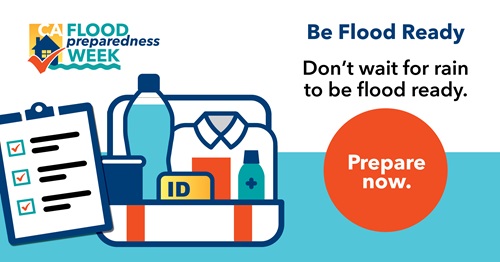Ways You Can Be Flood Ready

Take action to be flood ready
Did you know that every county in California has been declared a federal flood disaster area at least once in the last 20 years?
California experiences many types of flooding: alluvial fan, debris flow, riverine, coastal, tsunami, flash, and localized floods.
Not every part of California experiences every type of flooding, but the results of each is the same: without proper preparedness, lives, homes, infrastructure and agriculture are lost, and damage to the environment and economy is likely.
It is crucial for people to prepare for flooding by following three basic steps:
- Be aware of your risk: Know whether your home is in a flood zone; pay attention to weather forecasts; and listen to local authorities.
- Be prepared: Always have an emergency evacuation kit ready; be prepared to evacuate early; have a household inventory with copies of critical documents; and have a plan for where you will go in an emergency and what to do with your pets.
- Take action: Evacuate immediately when advised to. Also, homeowners’ insurance does not cover damage due to flooding; consider purchasing flood insurance.
Prepare for Flooding
- Look up your address on MyHazards to discover hazards in your area and learn steps to reduce personal risk.
- Share flood preparedness information with neighbors, students, family, and friends.
- Teach them how to prepare an emergency supply kit and evacuation plan.
- Establish a family communication plan for emergencies. Your family may not be together during an emergency so think about how you will communicate and where you will meet following an evacuation. Periodically review your plan.
- Keep storm drains clear. If your property is prone to flooding, have sandbags, plastic sheeting, and other flood-fighting materials on hand.
- Learn how to turn off water, gas, and electricity connections to your home in the event that your home is flooded. Contact your local utility companies for their help.
- Do not try to escape rising floodwater by going into the attic unless you have roof access or unless it’s your only option.
- Consider flood insurance. Most homeowners’ insurance policies do not cover flood damage. Ask your insurance agent about obtaining flood insurance from the National Flood Insurance Program. Typically, a 30-day wait period is required before a flood insurance policy takes effect. Contact your insurance provider for more information.
- Driving through flood waters is extremely dangerous; more people are trapped and die in their vehicles than anywhere else during a flood.
- It’s important to be prepared and aware of potential hazards when you’re away from home.
- For more tips on vehicles and flood waters, see NOAA’s Flooding Safety Card (PDF), which can be printed and stored in the glovebox. “Turn around don’t drown!”™
- Maintaining emergency supply kits in your home, vehicle, and work can provide essential supplies during the initial days following a flood. Examples of emergency supply kits can be found at Ready.gov.
- Be sure to include any medications necessary for you and your family.
- If you have pets, you can access the list of supplies recommended by the Red Cross and other agencies.
- Periodically check supplies and refresh water, food, batteries, and first aid items when needed.
- Be aware of the possibility of flooding to make sure you and your family have adequate time to prepare for an evacuation. Maintain awareness of incoming storms, weather watches, warnings, and evacuations issued by the National Weather Service.
- Television and radio stations are a source of weather forecasts and emergency messages before and during a severe weather event.
- Consider purchasing a radio capable of picking up National Weather Service broadcast frequencies.
American Red Cross
The Red Cross has developed applications for your smartphone to help you understand and prepare for emergencies, including flooding. Download these applications from iTunes and Google Play app stores.
Federal Emergency Management Agency (FEMA)
The FEMA Mobile App helps you plan for and respond to natural disasters.
NOAA Weather Radio App
The NOAA Weather Radio App provides up-to-date weather information and alerts.
Flood Preparedness
Watch these videos to learn about:
Flood After Fire
- Being prepared if you live near an area burned by wildfire
- Learn about debris flows and why it's important to be aware and prepared
Or visit DWR's flood channel on YouTube to see more videos.
- In the last 30 years, an average of 86 people have died in floods each year in the United States. In the last 10 years, that annual average increased to 95. From 2015 to 2017, more than 100 people died annually because of floods.
- Six inches of fast-moving water can knock an adult off his or her feet.
- Six inches of water will reach the bottom of most passenger cars, causing loss of control and possible stalling.
- Eighteen inches of water will float most cars; two feet of water can float SUVs and trucks.
- It is extremely difficult to see how deep flood water is, so don’t drive through water on the roadway.
- Just one foot of water can cause more than $54,000 in damages to a $150,000 single-family home.
- A home in the 100-year floodplain is almost twice as likely to suffer damage from flooding than from fire during the life of a 30-year mortgage.
- Statewide, $5.4 billion in crops are in the 100-year floodplain.
- Statewide, 7.9 million people live and work in the 500-year floodplain.
Preparedness Resources
-
Ready.gov
Discover templates for preparedness kits, evacuation checklists, communication plans, and more.
-
FEMA Flood Maps
Enter your address to learn about your flood risk.
-
Listos
Preparedness checklists and guides in English and other languages.
Contact Us
Email us for more information about flood preparedness.
